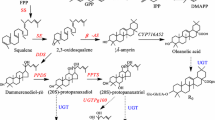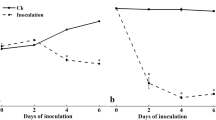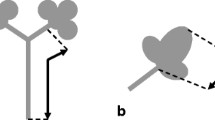Abstract
Ginseng root rot, caused by Fusarium oxysporum, is a serious disease in the ginseng industry in northeast China. This study aims to investigate the changes in ginseng physio-biochemistry following infection by Fusarium oxysporum, particularly the activities of cell wall degradation enzymes, antioxidant enzymes, and secondary metabolism-related enzymes. To do so, ginseng was artificially infected with a Fusarium oxysporum spore suspension, and changes in the activity of cell wall degrading enzymes (CWDEs), plant defense enzyme activity, malondialdehyde (MDA) and soluble sugar content were measured.
The results showed that the activities of the cell wall degrading enzymes in the infected ginseng were all, to different degrees, higher than those in the control group. In the infection group, the activities of carboxymethyl cellulase (Cx) and β -glucosidase (βG) reached a peak at 7 days after infection, the activities of polymethylgalacturonase (PMG) and polygalacturonase (PG) reached a peak at 14 days, and the activities of pectin methyl trans erasing (PGTE) and polygalacturonase (PMTE) reached peaked at 28 days. These results indicate that when ginseng was infected with Fusarium oxysporum, Cx and βG were the main cellulase, PG and PMG were the main pectinase, and the peak activity of the cellulases was earlier than that of pectinases.
After infection with Fusarium oxysporum, the physiological and biochemical indices in ginseng were closely related to its disease resistance response. The activities of superoxide dismutase (SOD), catalase (CAT), peroxidase (POD), phenylalanine ammonia lyase (PAL), polyphenol oxidase (PPO) and lipoxygenase (LOX) in the infection group reached a peak on a certain day. The results showed that the activities of SOD, CAT, POD, PAL, PPO and LOX were all activated when ginseng was infected by Fusarium oxysporum. The malondialdehyde (MDA) content in the infection group reached a peak at 7 days and was lower than that in the control group, indicating that the cell membrane damage of ginseng reached a maximum 7 days after inoculation. The soluble sugar content in the infection group was always higher than that in the control group. This result may be due to the enhanced respiration of the body, which promotes the degradation of starch and cellulose into soluble sugar, and is a self-protective reaction. In a word, ginseng has a defense effect after being infected by Fusarium oxysporum, and changes in CWDEs, plant defense enzymes activity, malondialdehyde and soluble sugar content in vivo to resist pathogenic invasion. The study provides a scientific basis for further exploring the mechanisms underlying the interaction between ginseng and root rot bacteria.






Similar content being viewed by others
References
Aamir, M., Kashyap, S. P., Zehra, A., Dubey, M. K., Singh, V. K., Ansari, W. A., Upadhyay, R. S., & Singh, S. (2019). Trichoderma erinaceum Bio-Priming Modulates the WRKYs Defense Programming in Tomato Against the Fusarium oxysporum f. sp. lycopersici (Fol) Challenged Condition. Frontiers in Plant Science, 10, 911. https://doi.org/10.3389/fpls.2019.00911
Bhattacharya, A. (2013). Adaptive expression of host cell wall degrading enzymes in fungal disease: An example from fusarium root rot of medicinal Coleus. Pakistan Journal of Biological Sciences, 16(24), 2036–2040. https://doi.org/10.3923/pjbs.2013.2036.2040
Campbell, S. A., & Kessler, A. (2013). Plant mating system transitions drive the macroevolution of defense strategies. Proceedings of the National Academy of Sciences of the United States of America, 110(10), 3973–3978. https://doi.org/10.1073/pnas.1213867110
Chen, L., Wu, Q., He, T., Lan, J., Ding, L., Liu, T., Wu, Q., Pan, Y., & Chen, T. (2020). Transcriptomic and Metabolomic changes triggered by fusarium solani in common bean (Phaseolus vulgaris L.). Genes, 11(2), 177. https://doi.org/10.3390/genes11020177
DesRochers, N., Walsh, J. P., Renaud, J. B., Seifert, K. A., Yeung, K. K., & Sumarah, M. W. (2020). Metabolomic profiling of fungal pathogens responsible for root rot in American ginseng. Metabolites, 10(1), 35. https://doi.org/10.3390/metabo10010035
Diaz-Vivancos, P., Rubio, M., Mesonero, V., Periago, P. M., Barceló, A. R., Martínez-Gómez, P., & Hernández, J. A. (2006). The apoplastic antioxidant system in Prunus: Response to long-term plum pox virus infection. Journal of Experimental Botany, 57(14), 3813–3824. https://doi.org/10.1093/jxb/erl138
Dubery, I. A., & Slater, V. (1997). Induced defence responses in cotton leaf disks by elicitors from verticillium dahliae. Phytochemistry, 44(8), 1429–1434. https://doi.org/10.1016/S0031-9422(96)00635-8
Elsherbiny, E. A., Taher, M. A., & Elsebai, M. F. (2019). Activity of purpureocillium lilacinum filtrates on biochemical characteristics of sclerotinia sclerotiorum and induction of defense responses in common bean. European Journal of Plant Pathology, 155, 39–52. https://doi.org/10.1007/s10658-019-01748-5
Ezzat, A., Szabó, S., Szabó, Z., Hegedűs, A., Berényi, D., & Holb, I. J. (2021). Temporal patterns and inter-correlations among physical and antioxidant attributes and enzyme activities of apricot fruit inoculated with Monilinia laxa under salicylic acid and methyl Jasmonate treatments under shelf-life conditions. Journal of fungi (Basel, Switzerland), 7(5), 341. https://doi.org/10.3390/jof7050341
Far, A., Sd, A., Glnna, B., Qy, A., Xz, A., & Hz, A. (2021). Investigating the biocontrol potentiality of wickerhamomyces anomalus against postharvest gray mold decay in cherry tomatoes. Scientia Horticulturae, 285. https://doi.org/10.1016/j.scienta.2021.110137
Ferrareze, J. P., Fugate, K. K., Bolton, M. D., Deckard, E. L., Campbell, L. G., & Finger, F. L. (2013). Jasmonic acid does not increase oxidative defense mechanisms or common defense-related enzymes in postharvest sugarbeet roots. Postharvest Biology and Technology, 77, 11–18. https://doi.org/10.1016/j.postharvbio.2012.11.003
Gao, J., Wang, Y., Guan, Y. M., & Chen, C. Q. (2014). Fusarium cerealis, A new pathogen causing ginseng (Panax ginseng) root rot in China. Plant Disease, 98(10), 1433. https://doi.org/10.1094/PDIS-03-14-0328-PDN
Javeria, S., Kumar, A., Kharkwal, A. C., Varma, A., & Sharma, P. (2020). Evaluation of rhizospheric trichoderma species strains for producing cell wall-degrading and defense related enzymes in response to fusarium oxysporum f. sp. lentis. Indian Phytopathology, 73, –467. https://doi.org/10.1007/s42360-020-00262-7
Jayapala, N., Mallikarjunaiah, N. H., Puttaswamy, H., Gavirangappa, H., & Ramachandrappa, N. S. (2019). Rhizobacteria bacillus spp. induce resistance against anthracnose disease in chili (capsicum annuum l.) through activating host defense response. Egyptian Journal of Biological Pest Control, 29, 1–9. https://doi.org/10.1186/s41938-019-0148-2
Kurabachew, H., & Wydra, K. (2014). Induction of systemic resistance and defense-related enzymes after elicitation of resistance by rhizobacteria and silicon application against ralstonia solanacearum in tomato (solanum lycopersicum). Crop Protection, 57, 1–7. https://doi.org/10.1016/j.cropro.2013.10.021
Li, P. Q., Luo, H. Y., Meng, J. J., Sun, W. B., Wang, X. H., Lu, S. Q., Peng, Y. L., & Zhou, L. G. (2014). Effects of oligosaccharides from endophytic fusarium oxysporum Dzf17 on activities of defense-related enzymes in Dioscorea zingiberensis suspension cell and seedling cultures. Electronic Journal of Biotechnology, 17(4), 156–161. https://doi.org/10.1016/j.ejbt.2014.04.012
Mohammadi, M., & Kazemi, H. (2002). Changes in peroxidase and polyphenol oxidase activities in susceptible and resistant wheat heads inoculated with fusarium graminearum and induced resistance. Plant Science, 162, 491–498. https://doi.org/10.1016/S0168-9452(01)00538-6
Passardi, F., Penel, C., & Dunand, C. (2004). Performing the paradoxical: How plant peroxidases modify the cell wall. Trends in Plant Science, 9(11), 534–540. https://doi.org/10.1016/j.tplants.2004.09.002
Perincherry, L., Urbaniak, M., Pawłowicz, I., Kotowska, K., Waśkiewicz, A., & Stępień, Ł. (2021). Dynamics of fusarium mycotoxins and lytic enzymes during pea Plants' infection. International Journal of Molecular Sciences, 22(18), 9888. https://doi.org/10.3390/ijms22189888
Reeleder, R., Roy, R., & Capell, B. (2002). Seed and root rots of ginseng (Panax quinquefolius L.) caused by Cylindrocarpon destructans and fusarium spp. Journal of Ginseng Research, 26, 151–158 https://www.researchgate.net/publication/275715006
Reeleder, R. D., & Brammall, R. A. (1994). Pathogenicity of pythium species, cylindrocarpon destructans, and rhizoctonia solani to ginseng seedlings in Ontario. Canadian Journal of Plant Pathology, 16(4), 311–316. https://doi.org/10.1080/07060669409500736
Resende, R. S., Rodrigues, F. Á., Cavatte, P. C., Martins, S. C., Moreira, W. R., Chaves, A. R., & Damatta, F. M. (2012). Leaf gas exchange and oxidative stress in sorghum plants supplied with silicon and infected by Colletotrichum sublineolum. Phytopathology, 102(9), 892–898. https://doi.org/10.1094/PHYTO-01-12-0014-R
Sharafaddin, A. H., Hamad, Y. K., El-Komy, M. H., Ibrahim, Y. E., Widyawan, A., Molan, Y. Y., & Saleh, A. A. (2019). Cell wall degrading enzymes and their impact on fusarium proliferatum pathogenicity. European Journal of Plant Pathology, 155, 871–880. https://doi.org/10.1007/s10658-019-01818-8
Stangarlin, J. R., Kuhn, O. J., Toledo, M. V., Portz, R. L., Schwanestrada, K., & Pascholati, S. F. (2011). The plant defense against pathogens. Scientia Agraria Paranaensis, 10, 18–46.
Tahsili, J., Sharifi, M., Safaie, N., Esmaeilzadeh-Bahabadi, S., & Behmanesh, M. (2014). Induction of lignans and phenolic compounds in cell culture of linum album by culture filtrate of fusarium graminearum. Journal of Plant Interactions, 9(1), 412–417 https://www.researchgate.net/publication/273959878
Vurro, M., & Ellis, B. E. (1997). Effect of fungal toxins on induction of phenylalanine ammonia-lyase activity in elicited cultures of hybrid poplar. Plant Science, 126(1), 29–38. https://doi.org/10.1016/S0168-9452(97)00094-0
Wang, F., Zhang, R., Yuan, Z., & Chen, P. (2021). Biological prevention and control of pitaya fruit canker disease using endophytic fungi isolated from papaya. Archives of Microbiology, 203(7), 4033–4040. https://doi.org/10.1007/s00203-021-02378-4
Wei, Y., Tian, Y., Wang, Y., & Gao, K. (2019). Effects of combination of chaetomium globosum and bacillus subtilis on defense enzyme activity of cucumber fusarium wilt. Shandong Agricultural Sciences, 51, 72–79. https://doi.org/10.14083/j.issn.1001-4942.2019.07.016
Xiao, C., Yang, L., Zhang, L., Liu, C., & Han, M. (2016). Effects of cultivation ages and modes on microbial diversity in the rhizosphere soil of Panax ginseng. Journal of Ginseng Research, 40(1), 28–37. https://doi.org/10.1016/j.jgr.2015.04.004
Xie, J. H., Chai, T. T., Xu, R., Liu, D., Yang, Y. X., Deng, Z. C., Jin, H., & He, H. (2017). Induction of defense-related enzymes in patchouli inoculated with virulent ralstonia solanacearum. Electronic Journal of Biotechnology, 27: 63–69. https://doi.org/10.1016/j.ejbt.2017.03.007.
Yadav, M., Dubey, M. K., & Upadhyay, R. S. (2021). Systemic resistance in Chilli pepper against anthracnose (caused by Colletotrichum truncatum) induced by Trichoderma harzianum, Trichoderma asperellum and Paenibacillus dendritiformis. Journal of fungi (Basel, Switzerland), 7(4), 307. https://doi.org/10.3390/jof7040307
Zhang, Q., Yong, D., Zhang, Y., Shi, X., Li, B., Li, G., Liang, W., & Wang, C. (2016). Streptomyces rochei a-1 induces resistance and defense-related responses against botryosphaeria dothidea in apple fruit during storage. Postharvest Biology and Technology, 115, 30–37. https://doi.org/10.1016/j.postharvbio.2015.12.013
Zheng, D. F., Liang, X. L., Zuo, Y. H., Yu-Xian, Z., Feng, N. J., Ji-Dao, D. U., & Ding, X. W. (2004). Pathogen (fusarium oxysporum) of soybean root rot impacting on biochemical and physiological indexes of soybean seedling. Chinese Journal of Oil Crop Scieves, 26(3), 57–61. https://doi.org/10.1300/J064v24n01_09
Acknowledgments
This work was supported by the the Jilin Province Science and Technology Development Plan (20200708060YY), the Science and technology research project of Education Department of Jilin Province (JJKH20220880KJ), and the Young Scientist Project of Changchun University of Chinese Medicine (QNKXJ2-2021ZR15).
Author information
Authors and Affiliations
Corresponding authors
Ethics declarations
Human participants and/or animals
This article does not contain any studies with human participants or animals performed by any of the authors.
Informed consent
Informed consent was obtained from all individual participants included in the study.
Rights and permissions
Springer Nature or its licensor (e.g. a society or other partner) holds exclusive rights to this article under a publishing agreement with the author(s) or other rightsholder(s); author self-archiving of the accepted manuscript version of this article is solely governed by the terms of such publishing agreement and applicable law.
About this article
Cite this article
Feng, L., Zhao, G., Sun, R. et al. Dynamic changes in cell wall-degrading enzymes and physio-biochemistry of ginseng in response to fusarium oxysporum infection. Eur J Plant Pathol 165, 569–578 (2023). https://doi.org/10.1007/s10658-022-02628-1
Accepted:
Published:
Issue Date:
DOI: https://doi.org/10.1007/s10658-022-02628-1




